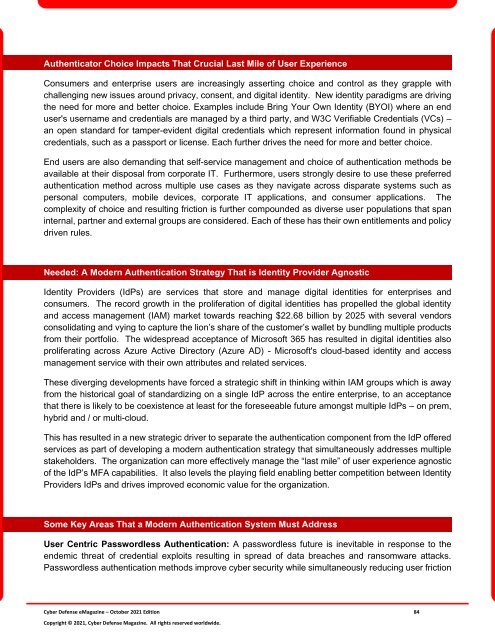Cyber Defense eMagazine October Edition for 2021
Cyber Defense eMagazine October Edition for 2021 #CDM #CYBERDEFENSEMAG @CyberDefenseMag by @Miliefsky a world-renowned cyber security expert and the Publisher of Cyber Defense Magazine as part of the Cyber Defense Media Group as well as Yan Ross, US Editor-in-Chief, Pieruligi Paganini, International Editor-in-Chief and many more writers, partners and supporters who make this an awesome publication! Thank you all and to our readers! OSINT ROCKS! #CDM #CDMG #OSINT #CYBERSECURITY #INFOSEC #BEST #PRACTICES #TIPS #TECHNIQUES #CYBERSECURITYAWARENESSMONTH
Cyber Defense eMagazine October Edition for 2021 #CDM #CYBERDEFENSEMAG @CyberDefenseMag by @Miliefsky a world-renowned cyber security expert and the Publisher of Cyber Defense Magazine as part of the Cyber Defense Media Group as well as Yan Ross, US Editor-in-Chief, Pieruligi Paganini, International Editor-in-Chief and many more writers, partners and supporters who make this an awesome publication! Thank you all and to our readers! OSINT ROCKS! #CDM #CDMG #OSINT #CYBERSECURITY #INFOSEC #BEST #PRACTICES #TIPS #TECHNIQUES #CYBERSECURITYAWARENESSMONTH
You also want an ePaper? Increase the reach of your titles
YUMPU automatically turns print PDFs into web optimized ePapers that Google loves.
Authenticator Choice Impacts That Crucial Last Mile of User Experience<br />
Consumers and enterprise users are increasingly asserting choice and control as they grapple with<br />
challenging new issues around privacy, consent, and digital identity. New identity paradigms are driving<br />
the need <strong>for</strong> more and better choice. Examples include Bring Your Own Identity (BYOI) where an end<br />
user's username and credentials are managed by a third party, and W3C Verifiable Credentials (VCs) –<br />
an open standard <strong>for</strong> tamper-evident digital credentials which represent in<strong>for</strong>mation found in physical<br />
credentials, such as a passport or license. Each further drives the need <strong>for</strong> more and better choice.<br />
End users are also demanding that self-service management and choice of authentication methods be<br />
available at their disposal from corporate IT. Furthermore, users strongly desire to use these preferred<br />
authentication method across multiple use cases as they navigate across disparate systems such as<br />
personal computers, mobile devices, corporate IT applications, and consumer applications. The<br />
complexity of choice and resulting friction is further compounded as diverse user populations that span<br />
internal, partner and external groups are considered. Each of these has their own entitlements and policy<br />
driven rules.<br />
Needed: A Modern Authentication Strategy That is Identity Provider Agnostic<br />
Identity Providers (IdPs) are services that store and manage digital identities <strong>for</strong> enterprises and<br />
consumers. The record growth in the proliferation of digital identities has propelled the global identity<br />
and access management (IAM) market towards reaching $22.68 billion by 2025 with several vendors<br />
consolidating and vying to capture the lion’s share of the customer’s wallet by bundling multiple products<br />
from their portfolio. The widespread acceptance of Microsoft 365 has resulted in digital identities also<br />
proliferating across Azure Active Directory (Azure AD) - Microsoft's cloud-based identity and access<br />
management service with their own attributes and related services.<br />
These diverging developments have <strong>for</strong>ced a strategic shift in thinking within IAM groups which is away<br />
from the historical goal of standardizing on a single IdP across the entire enterprise, to an acceptance<br />
that there is likely to be coexistence at least <strong>for</strong> the <strong>for</strong>eseeable future amongst multiple IdPs – on prem,<br />
hybrid and / or multi-cloud.<br />
This has resulted in a new strategic driver to separate the authentication component from the IdP offered<br />
services as part of developing a modern authentication strategy that simultaneously addresses multiple<br />
stakeholders. The organization can more effectively manage the “last mile” of user experience agnostic<br />
of the IdP’s MFA capabilities. It also levels the playing field enabling better competition between Identity<br />
Providers IdPs and drives improved economic value <strong>for</strong> the organization.<br />
Some Key Areas That a Modern Authentication System Must Address<br />
User Centric Passwordless Authentication: A passwordless future is inevitable in response to the<br />
endemic threat of credential exploits resulting in spread of data breaches and ransomware attacks.<br />
Passwordless authentication methods improve cyber security while simultaneously reducing user friction<br />
<strong>Cyber</strong> <strong>Defense</strong> <strong>eMagazine</strong> – <strong>October</strong> <strong>2021</strong> <strong>Edition</strong> 84<br />
Copyright © <strong>2021</strong>, <strong>Cyber</strong> <strong>Defense</strong> Magazine. All rights reserved worldwide.


















